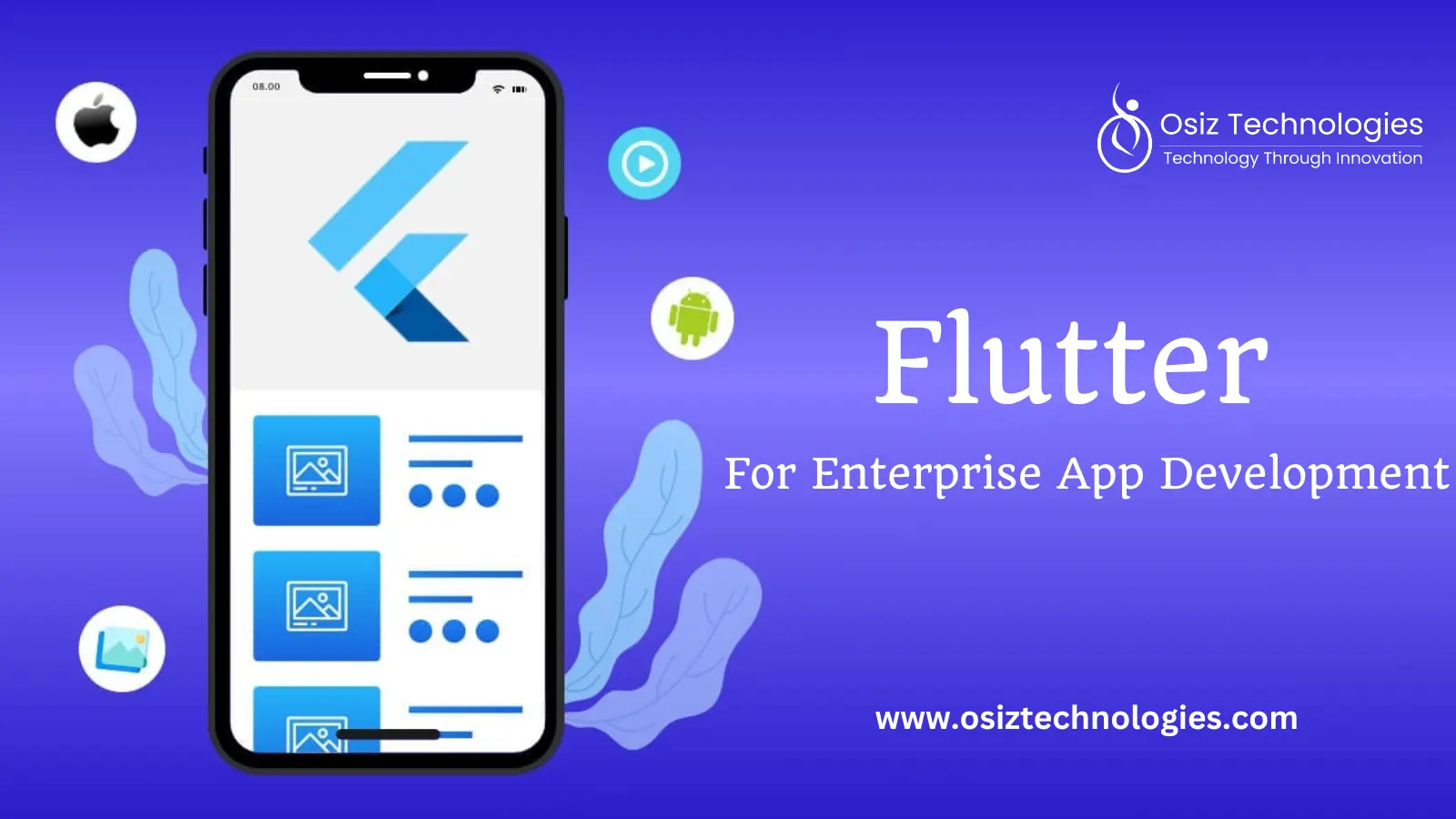Businesses in Today's digital world seek simple, flexible, and cost-efficient solutions to deliver high-quality applications on multiple platforms. Flutter, the open-source UI toolkit from Google, has become a strong, powerful option for developing enterprise applications. It can generate visually appealing, natively compiled apps from a unified codebase and is revolutionizing how companies tackle mobile and web development.
What is Flutter?
Flutter development framework is designed for cross-platform development by Google. It is developed using the programming language "DART". With Flutter, development is quick and easy, user interfaces are user-friendly and flexible, and performance is comparable to native applications. Developers can create applications for Android, iOS, web, desktop, and embedded systems using one codebase with Flutter.
Reasons Enterprises Prefer Flutter
Single Codebase, Multiple Platforms
Businesses must consider the cost of starting and developing their projects quickly. Flutter improves both by allowing developers to create code a single time and deploy it on multiple platforms such as Android, iOS, web, and desktop. This greatly minimizes the necessity for managing multiple codebases.
Rapid Growth Continuation
The use of Flutter improves the efficiency of development and testing by enabling real-time updates without application restart, such as hot reload. This facilitates rapid iterations for teams, making them more adaptable to evolving business needs.
Rich, Tailorable Interface
Flutter is a widget-based framework that allows for quick and easily customizable UI design. The aim is to maintain brand consistency across platforms and ensure that users are fully engaged with the experience without any limitations.
High-Performance, Native-Like Experience
Flutter-developed enterprise mobile applications install UI components directly on the device, avoiding the need for platform intermediaries that could cause delays. As a result, projects for Flutter enterprise app development provide seamless and efficient animations and interactions, creating a native-like experience across all platforms. Enterprise applications demand intricate data visualization alongside a dynamic user interface, which Flutter enables for developers.
Cost Efficiency and Long-Term ROI
Flutter reduces development and maintenance costs by eliminating the need for separate platform teams, enabling simultaneous testing across platforms, and supporting faster deployment cycles. Enterprises often see a significant return on investment within the first year, particularly when using Flutter to modernize legacy applications.
Use Cases of Flutter in Enterprise Development
Enterprise applications, such as CRM, ERP, or HRM systems that demand dependability and high security features, are well-suited for Flutter. It is also perfect for customer-oriented mobile applications such as banking or e-commerce services that necessitate captivating, high-performing user interfaces. For field service teams, Flutter enables real-time data syncing and offline capabilities, allowing uninterrupted functioning while mobile. Furthermore, businesses can utilize Flutter to create dynamic dashboards and analytics applications featuring interactive graphs and comprehensive data visualizations.
Internal Business Applications
Creating internal business applications with Flutter can be an excellent way to increase efficiency across different departments and organizations. It is used in building CRM systems that lead, customer information, sales, and support requests. ERP systems created with Flutter help in integrating essential functions such as finance, procurement, inventory management, and supply chain operations. Solutions for HR management can also be constructed to manage recruitment processes, onboarding, leave monitoring, performance evaluations, and payroll tasks. Furthermore, Flutter is well-suited for developing project management applications that facilitate task monitoring, timeline supervision, and team collaboration, all while offering a uniform user experience across different devices.
Client-Facing Applications
Flutter is unique in developing consumer-centric apps that enhance user engagement. It is suitable for developing client portals where individuals can oversee profiles, check order statuses, send inquiries, and monitor developments. In sectors such as healthcare, automotive, and hospitality, Flutter facilitates service booking systems for scheduling appointments. It is also ideal for creating e-commerce applications, delivering fluid shopping experiences complete with inventory oversight, payment processing, and customer assistance. Moreover, Flutter can drive loyalty program applications to handle rewards, point systems, and special promotions, guaranteeing a cohesive and streamlined user experience across various platforms.
Finance and Accounting
Flutter is exceptionally powerful for building finance and accounting applications that enhance essential business operations. It can facilitate the creation of expense tracking applications that enable users to submit and approve reimbursements while overseeing budgets. Regarding invoicing and billing, Flutter allows for the straightforward generation, tracking, and distribution of invoices. Moreover, it assists in developing procurement systems that optimize vendor management, requisitions, and approval processes, aiding businesses in sustaining financial efficiency and oversight.
What Lies Ahead for Flutter in Enterprise App Development
The quickening of digital transformation in various industries is resulting in more and more demands on businesses to improve their tools, operations, and user experiences.Flutter, the open-source UI toolkit from Google, has quickly become a significant competitor in this field. However, what lies ahead for Flutter in the realm of enterprise application development?
Growing Adoption Among Enterprises
Flutter is quickly becoming a well-known technology in the business sector as more companies acknowledge its ability to reduce development time and expenses. With leading organizations such as Google, Alibaba, and BMW already making use of it, more enterprises are turning to Flutter to create solid, flexible, and cross-platform internal tools and applications for customers. Its capability to provide native-like performance across various platforms positions it as a formidable candidate for upcoming enterprise environments.
Improved Integration of Backend and DevOps Environment.
The path forward for Flutter is found in deeper integration with corporate backends, cloud services, and DevOps processes. Resources and libraries for Firebase, REST APIs, GraphQL, and business authentication mechanisms (such as OAuth and SSO) are consistently advancing. Consequently, Flutter is becoming increasingly adept at accommodating extensive enterprise operations, where secure data management and continuous integration/delivery (CI/CD) are essential.
Expansion into Web and Desktop, Powered by AI
Flutter is now more than just a mobile-based framework, as it is also making progress towards becoming a web and desktop application. As businesses seek seamless experiences across various devices, Flutter’s compatibility with all leading platforms establishes it as a strong candidate for future-ready application development. Moreover, the incorporation of AI and machine learningsuch as chatbots, recommendation systems, and predictive analyticswill further bolster Flutter’s significance in crafting smart, user-focused enterprise solutions.
Integrated technologies
Flutter will undergo an important upgrade in functionality by incorporating several cutting-edge technologies. Modern innovations like AR/VR and AI/ML are becoming prevalent in nearly all mobile applications. This integration will enhance enterprise app development, making it more powerful and versatile.
Robust third-party support
The future of Flutter enterprise mobile app development is brighter with robust third-party support. A growing ecosystem of third-party plugins and libraries are likely to enhance Flutter app capability. This means more pre-built solutions for common enterprise needs are on the way, reducing costs and time.
|
Features |
Flutter |
React Native |
Native Development |
|
Code Reusability |
High |
High |
Low |
|
UI Customization |
Excellent |
Limited |
Excellent |
|
Performance |
Near Native |
Moderate |
Native |
|
Development Speed |
Fast |
Fast |
Slower |
|
Maintanence |
Easy |
Medium |
Costly |
When Should Enterprises Choose Flutter?
When businesses require quick and effective application launches on multiple platforms, they should contemplate Flutter. It is an intelligent option for providing a uniform user experience across different devices, particularly when an attractive UI and seamless performance are critical. Additionally, Flutter contributes to lowering ongoing maintenance expenses due to its unified codebase strategy. Whether you are a new venture or a significant corporation, Flutter is perfect if your emphasis is on innovation, speed, and achieving user-focused design while maintaining high performance. Partnering with an experienced app development company like Osiz can further enhance the benefits of Flutter, offering expert guidance, end-to-end support, and customized solutions to ensure your application meets both technical and business goals efficiently.
Listen To The Article
Recent Blogs

X-Mas 30%
Offer











